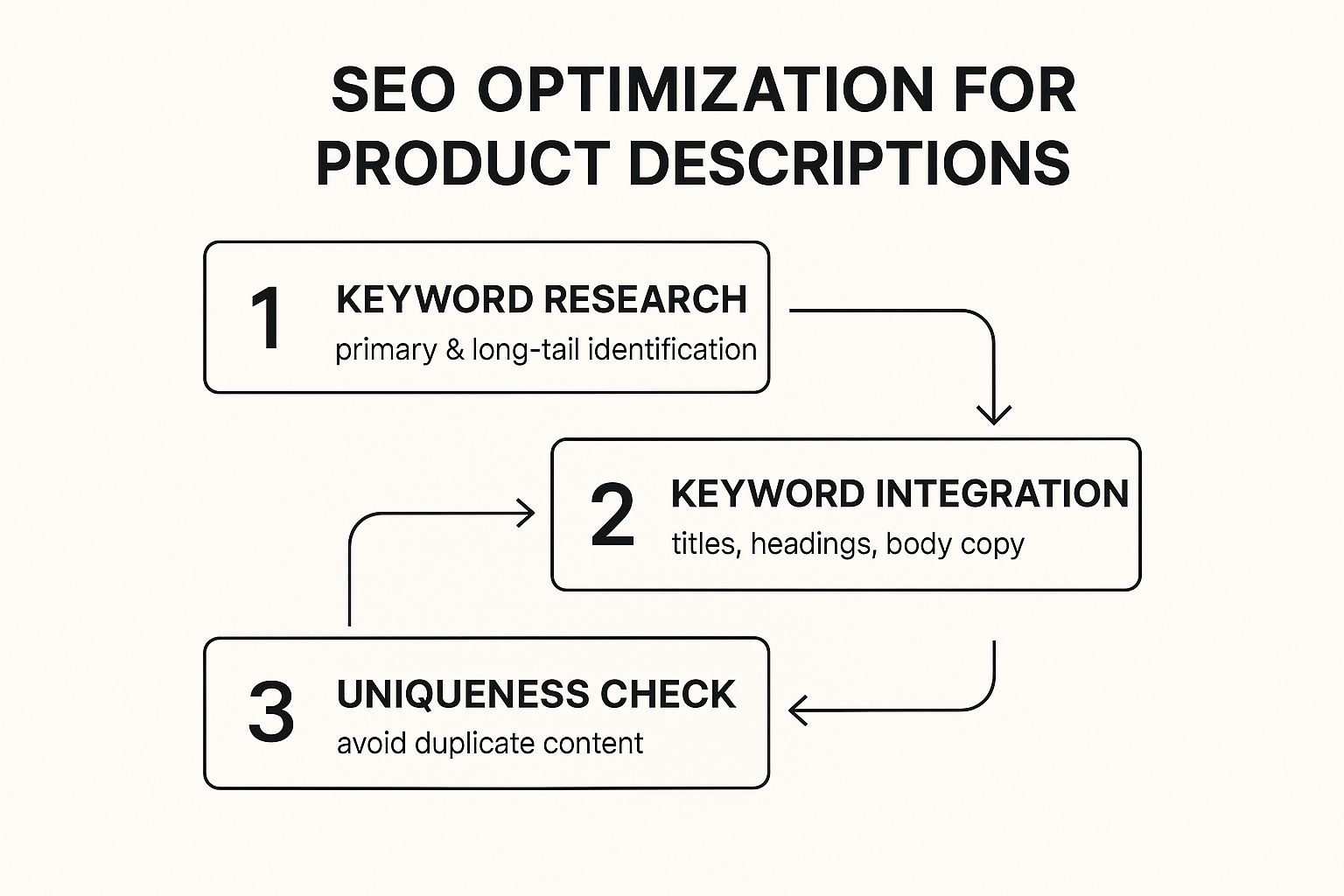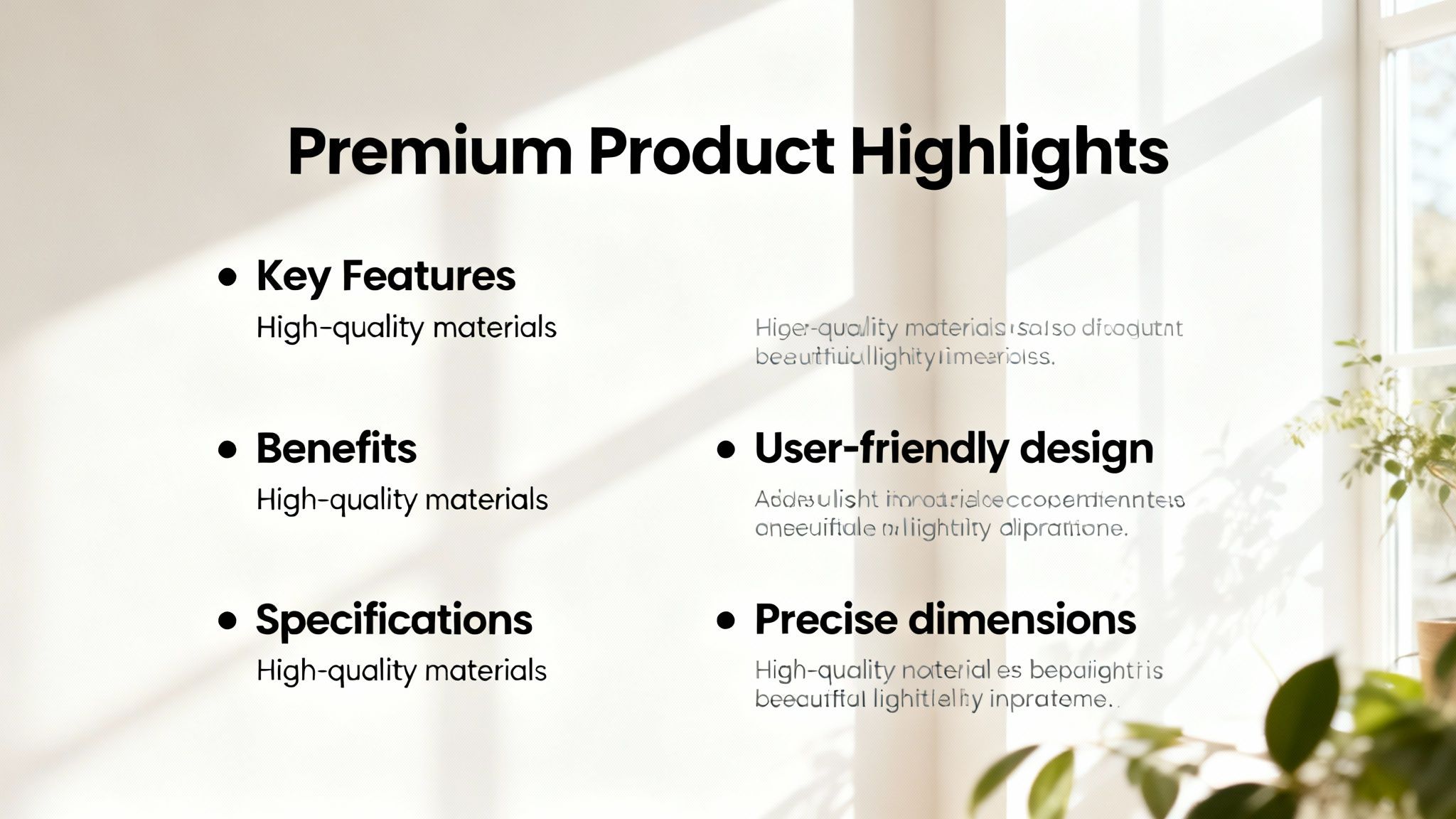
Meta Description: Learn how to write a product description that converts. This guide covers understanding your audience, crafting compelling copy, SEO, and using AI for efficiency.
Tired of product pages that get clicks but no sales? The problem often comes down to one thing: a flat, uninspired product description. Many marketers and creators spend a fortune on ads to get traffic, only to lose potential customers with generic copy that lists features instead of benefits. It’s a common pain point that silently kills conversion rates. This guide offers a clear solution, walking you through a step-by-step process to write descriptions that don't just describe—they connect with your ideal customer, solve their problems, and persuade them to click "add to cart." We’ll even explore how AI tools like MediaWorkbench.ai can streamline this entire process for you.
Why Great Product Descriptions Matter More Than Ever

In the crowded world of e-commerce, getting traffic is only half the battle. Think of your product description as your best salesperson—one that works 24/7. It’s the critical link that turns a casual browser into a confident buyer. A truly compelling description doesn't just list what the product is (features); it highlights how it makes your customer’s life better (benefits). This guide will show you how to write a product description that connects with your audience, uses proven copywriting formulas, and is optimized for search engines. By understanding your customer's real motivations, you can craft copy that boosts conversions and strengthens your brand voice.
1. Know Your Audience: The Foundation of Persuasive Copy

Before writing a single word, you must understand who you're writing for. A product description that tries to appeal to everyone ends up connecting with no one. The foundation of persuasive copy is a detailed buyer persona. This isn't just about demographics; it's about diving deep into your ideal customer's mindset. What are their biggest challenges? What are they trying to achieve? For example, a marketer selling sustainable yoga mats isn't just selling cushioned foam; they're selling an eco-conscious lifestyle. Their descriptions must reflect those values to resonate with their specific audience.
How to Gather Customer Insights
To build an effective persona, you need to become a detective. Here’s how to find the insights that will fuel your copy:
- Mine Competitor Reviews: Scour competitor product pages and Amazon listings. Look for patterns in what people love, what frustrates them, and the exact language they use. This is a goldmine of unfiltered customer voice.
- Analyze Social Media: Pay attention to comments on your posts and your competitors'. What questions are asked repeatedly? What features get people genuinely excited?
- Use Customer Surveys: Sometimes, the best way to get answers is to ask directly. Use simple tools like Google Forms to ask about their pain points and what they value most in a product like yours.
2. Craft Compelling Copy That Converts
Once you know your customer, it's time to turn those insights into words that sell. The most common mistake marketers make is focusing on features instead of benefits. Nobody buys a drill because they want a drill; they buy it because they want a hole. The drill is the feature; the hole is the benefit. Your job is to connect those dots clearly.
Translate Features into Benefits
The core of great product copy is translating technical specs into real-world advantages. A shopper might not care that a backpack is made from "ripstop nylon," but they will care that it's "durable enough for any adventure."
- Feature: A portable speaker with a 10,000mAh battery.
- Benefit: Enjoy up to 24 hours of non-stop music—so your party never has to end early.
- Feature: A coffee mug with vacuum-insulated stainless steel.
- Benefit: Keep your coffee steaming hot for hours, so it's still perfect after a long meeting.
This simple shift in perspective is everything. It moves the focus from your product to your customer's life, creating a genuine connection. For more fundamental tips, explore our guide on copywriting tips for beginners.
👉 Try MediaWorkbench.ai for free – generate compelling product descriptions and social media content in one place!
3. Optimize Your Descriptions for Search Engines (SEO)
A brilliant product description is useless if customers can't find it. This is where search engine optimization (SEO) is critical. It’s about building a bridge between your product and the exact phrases people are typing into Google. Without that connection, you're essentially invisible to a huge pool of potential buyers who are actively searching for what you sell.
Find and Use the Right Keywords
It all starts with keyword research. You need to find a primary keyword (the broad category) and several long-tail keywords (specific phrases that signal buyer intent).
- Primary Keyword: "ergonomic office chair"
- Long-tail Keywords: "lumbar support chair for home office," "adjustable mesh office chair for back pain"
Once you have your keywords, weave them naturally into your copy. Here’s where to place them for maximum impact:
- Product Title (H1): Must include your primary keyword.
- Subheadings (H2s/H3s): Use long-tail keywords to break up text.
- Body Copy: Sprinkle keywords throughout, but always prioritize readability.
- Image Alt Text: Describe the image accurately and include the primary keyword.
Always write a unique description for every product. Search engines penalize duplicate content, so copying from a manufacturer is a major SEO mistake. For a deeper dive, check out our guide on essential SEO copywriting tips.

4. Design for Readability and Impact

Even the most persuasive copy will fail if it's a giant wall of text. Online shoppers are scanners. Your job is to make your product description effortlessly scannable so you can guide their eyes to the information that matters most. Good formatting makes key benefits pop and respects your customer's limited attention span.
Use Formatting to Your Advantage
- Short Paragraphs: Keep paragraphs to 1-3 sentences. This creates white space and makes the page feel more approachable.
- Bold Key Phrases: Use bold text to draw the reader’s focus to your most compelling points. It’s a visual tap on the shoulder that says, "Pay attention to this."
- Strategic Bullet Points: Bullet points are perfect for listing specs, features, or a series of benefits without bogging the reader down. They allow a shopper to get the essential details in seconds.
- 100% Organic Cotton: Incredibly soft and breathable for all-day comfort.
- Reinforced Stitching: Built to withstand daily wear and tear.
- Eco-Friendly Dyes: Vibrant colors without harsh chemicals.
Conclusion: Turn Your Words Into Revenue
We’ve covered the entire framework for how to write a product description that sells: understanding your customer, translating features into benefits, optimizing for search, and designing for readability. This isn't just a collection of tips; it's a proven process for making your words work harder to drive sales. The next step is to put it into action. Pick a product page that isn't performing and apply these principles. By focusing on solving a customer's problem, you create a genuine connection that strengthens your brand and boosts your bottom line.
Ready to create compelling product descriptions at scale? Try MediaWorkbench.ai for free and see how our AI tools can generate high-converting copy in seconds, helping you save time and drive more sales.

